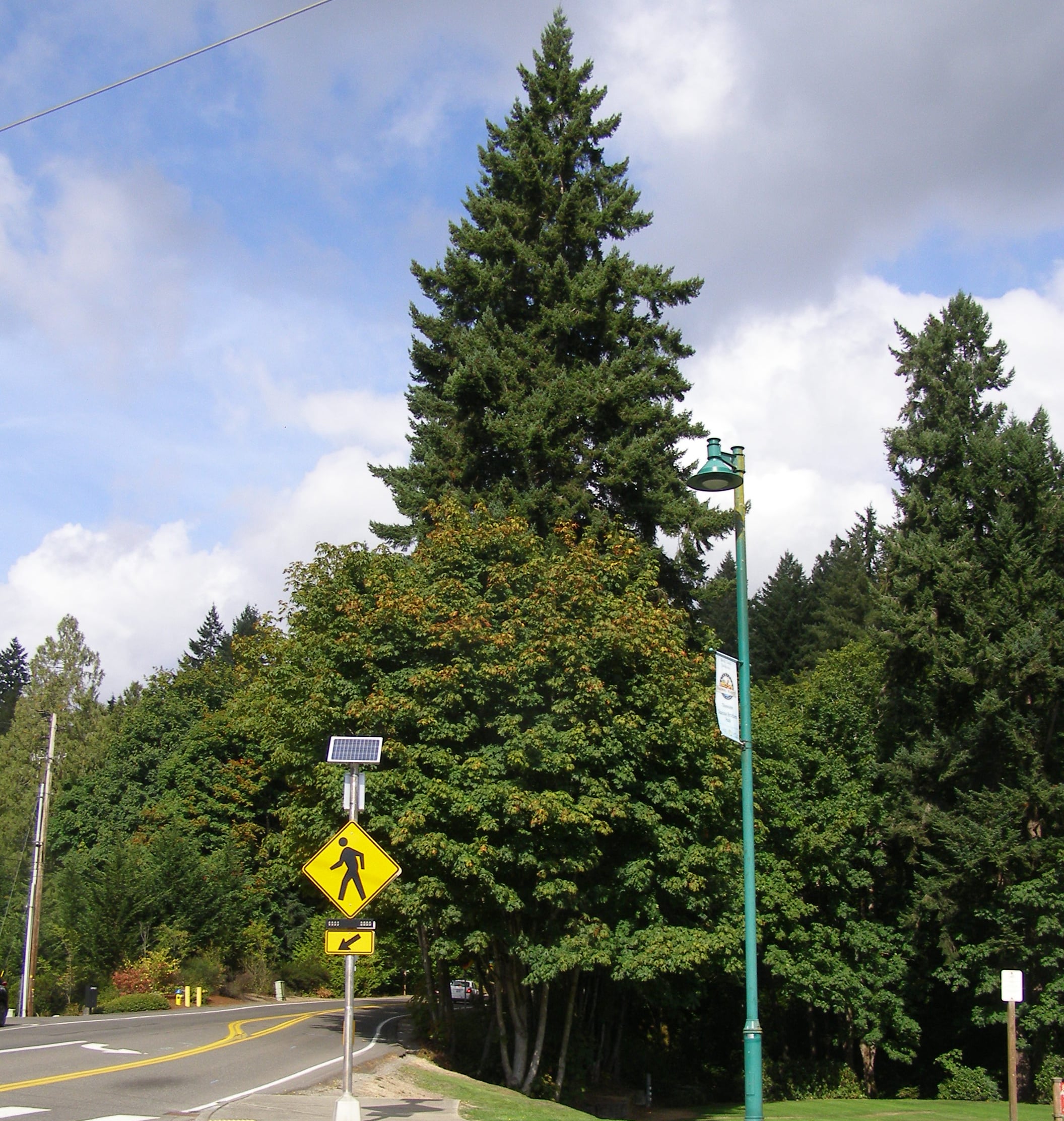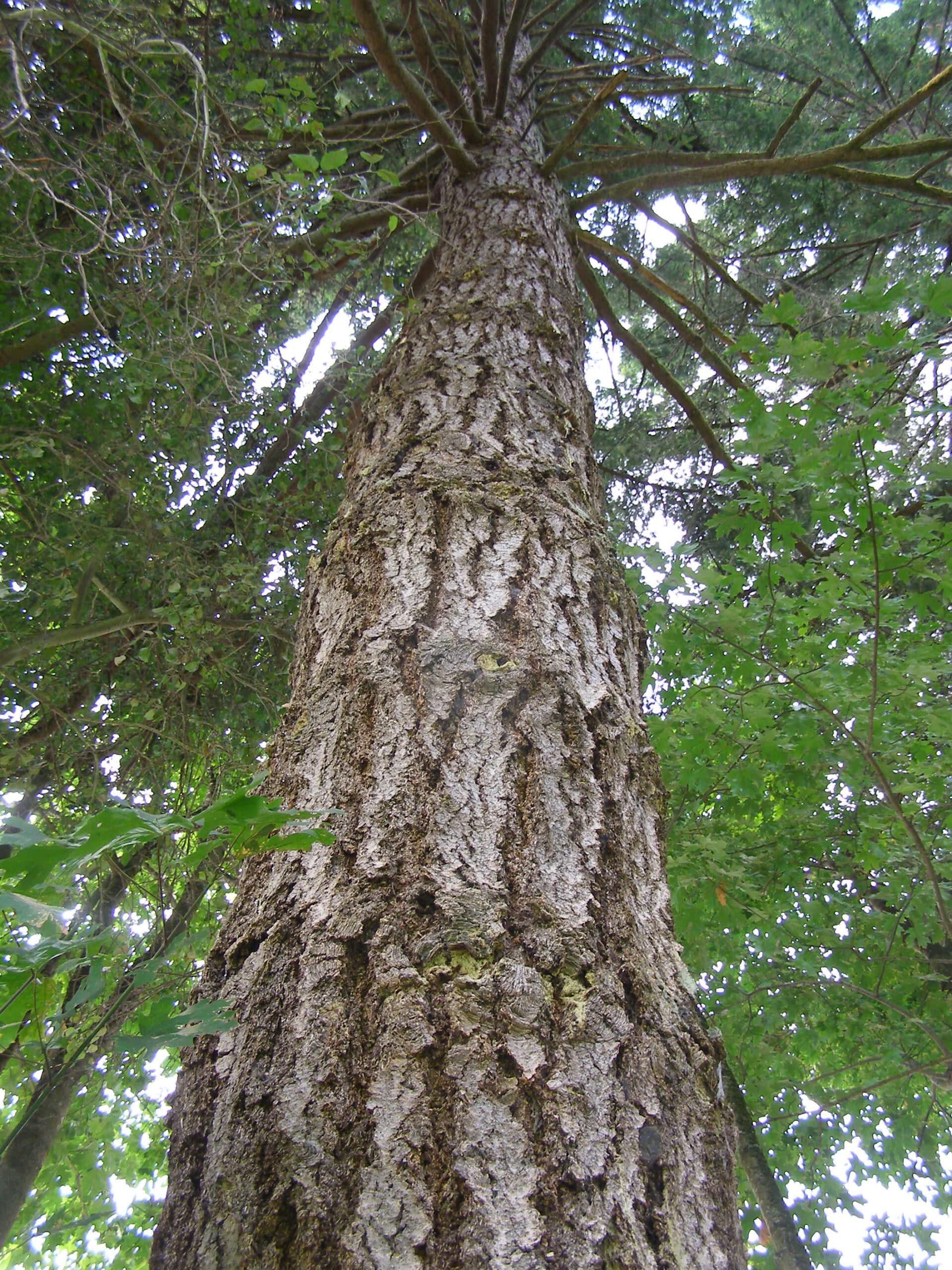Arts & Entertainment Community
Gig Harbor Now and Then: Donkey Creek Park Douglas fir isn’t all that old … for a tree

Behind a much shorter bigleaf maple, this beautiful Douglas fir, on the west side of Gig Harbor’s Donkey Creek Park, is the subject of the two questions below. Photo by Greg Spadoni.
Our most recent Gig Harbor Now and Then questions of local history involve Gig Harbor’s first big industry, logging. Specifically, they concern a single second-growth Douglas fir tree standing tall in the city of Gig Harbor’s Donkey Creek Park. They are:
Arts & Entertainment Sponsor
Arts & Entertainment stories are made possible in part by the Gig Harbor Film Festival, a proud sponsor of Gig Harbor Now.
How old is the Donkey Creek Park fir tree?
Answer: Between 50 and 100 years.
To pare it down a little further, it’s less than 90 years old.
The best way to determine the age of a tree is to take a core sample low on the trunk with a tool called an increment borer. But we didn’t have to do that with this specimen. A photograph in the Harbor History Museum, taken no earlier than 1935, shows the roadway next to where the tree now stands. It shows no trees of any kind lining the road. Today’s 136-foot Douglas fir had not yet sprouted when the picture was taken, so it cannot be more than 88 years old. It could even be somewhat younger.
Old-growth Douglas fir in the greater Gig Harbor area with diameters equal to that of the Donkey Creek Park fir would have averaged closer to 300 years of age. Their height would’ve averaged … well, that’s really difficult to determine. Surviving records concerning the size of old growth on the Gig Harbor and Key peninsulas address only the diameter and clear trunk lengths (the portion of the trunk without limbs).
The records of diameters closely match the physical evidence left behind: The stumps, some of which still exist today, 100 or more years after they were cut. But nothing remains to give an indication of the height of the trees that stood on those stumps. I’ve measured the height of just two local old-growth Douglas firs, the largest being in Spadoni Brothers’ Key Peninsula gravel pit. It was five feet in diameter and 230 feet tall, but was missing perhaps 30 feet of its top.
While the diameter was on the high side of average for local old growth, I don’t know if it was average in height. All that can be said for sure is that the average four-foot diameter Douglas fir on the Peninsula in 1900 would’ve been a lot taller than 136 feet.
In dollars, how much would today’s Donkey Creek Park fir have been worth if it was its present size in 1900?
Answer: zero.
The tree, while fairly sizeable, would’ve had no monetary value in 1900. Though thick, the trunk is both crooked and full of knots. It would’ve made terrible lumber. Because of the knots alone, it would’ve been unnecessarily difficult to split into cordwood for steamer fuel or firewood for homes. With countless better ones to choose from, in 1900 the Donkey Creek Park tree would’ve been left standing.

The trunk of the Donkey Creek Park tree is crooked and full of knots. Photo by Greg Spadoni.
A Daylight Saving Time free-for-all
One of the intangible, yet very real, benefits of recorded history is that much can be learned by studying it long after it occurred. And by adapting some of those lessons to the present day, we can often improve the quality of our own lives.
We’re going to do exactly that in the next few paragraphs.
With most of the country having turned back its clocks one hour yesterday, Nov. 5, the semi-annual gripes, complaints, and objections to the practice of Daylight Saving Time are once again in the news. That makes this a choice opportunity to see what history can teach us about the now-routine changing of the clocks.
To do that, we’ll go back to the early years of the baby boom generation. As any boomer can tell you (and probably already has), things were immeasurably better in the 1950s than they are today.
The year 1952 is just one case in point. In that year there was no federal mandate to turn clocks forward in the spring and back in the fall. Neither did the state of Washington force people to make the change. Instead, it was up to local municipalities to decide for themselves. As we will see, it worked very well.
In 1952, Seattle went on Daylight Time in the spring. Tacoma had already held an advisory election on the matter and the people voted to remain on Standard Time, which the city of Everett had been doing for years.
The Pierce County commissioners decided not to force anyone else in the county to go on Pacific Daylight Time, even though they turned the clocks ahead in certain county offices. However, at the same time, they encouraged citizens who wanted to turn their clocks forward to go ahead and do it. And why not? What could be more satisfying and efficient than a county-wide free-for-all?
Before the time change was scheduled to take place for those observing it, the mayor of Tacoma decided to ignore the advisory vote of the citizens and put the city on Daylight Saving Time anyway. Or at least most of the city. That resulted in the Tacoma News Tribune reporting that “…in the heart of Tacoma there is a time island, bounded on the north by So. 10th St., on the east by So. G St., on the south by So. 11th St., and on the west by an alley, the building upon which is commonly known as the county courthouse, where the time is standard time, except for the courtrooms, the prosecutor’s office, and the clerk’s office, all of which have privately adopted daylight saving time. [Pierce County Commissioner Bob] Gleason, however, has claimed squatter’s rights on the hallways, and declares them to be on standard time.”
Other municipalities in the Puget Sound region made similar decisions, with equally smooth results. Buckley and Enumclaw both adopted Daylight Saving Time in a mostly successful effort to be aligned with Seattle. And then both switched back to Standard Time a month sooner than the state’s biggest city did. How could that possibly have caused anyone even the slightest confusion?
The Gig Harbor Town Council voted to go on Daylight Time to be in sync with Seattle and Bremerton, before Tacoma’s mayor decided to do the same. There were some decisions affecting time that were out of reach of the town council, but in what possible way could it have been of any disruption that the Gig Harbor post office would have to “remain on Standard time until orders from higher-ups decree otherwise,” as The Peninsula Gateway put it?
In spite of how easy and effortless it must have been to cope with neighboring municipalities—sometimes in the same building — being an hour apart (for no obvious or practical reason), in that year of 1952 there was a faction of disruptors in the state bent on ruining it for everyone. They organized themselves, and put an initiative on the ballot in November which would outlaw Daylight Saving Time in the state of Washington. It passed, 52% to 48%.
Although freedom of choice was forcibly wrenched from the wiggling fingers of every Washingtonian eager to spin the dials of their clocks at their personal whim, there was at least one saving grace during the same election. Another ballot measure, an initiative organized by “a group of militant housewives” who outmaneuvered the dairy lobby, also passed. It allowed margarine sold in retail stores to be colored yellow for the first time since artificially tinting its naturally off-white hue had been outlawed in 1899. Really.
A brief question
Now that we’ve eaten up most of our allotted space on the website for this week’s column, we have room only for a very short question of local history. That’s actually good, for we’ve had a very short one in waiting that needed the extra filler. And if any single word best describes Gig Harbor Now and Then, it’s filler.
To give any kind of setup to today’s question beyond two simple statements would give it away, so we can’t do that. In a rather cold introduction, here are those two statements: In 1930 Flamo arrived in Gig Harbor. It’s still there, although is now known under another name.
Question: What is Flamo?
We can add that Flamo is not only still in Gig Harbor, but is all over the Gig Harbor and Key peninsulas.
Assigning a degree of difficulty to today’s question is kind of tricky. An internet search for “Flamo” brings so many results that it might be overwhelming. The answer is easy to find if you already know what it is, but lacking that, it probably rates a 4 (out of 5).
Gig Harbor Now and Then will have the answer on Nov. 20. Until then, you’re invited to visit the Gig Harbor Now Facebook page and post your guesses — or better yet, the detailed results of your extensive, intensive, and critical research into the hunt for the answer to the question: What is Flamo?
And what about freedom of choice in turning clocks ahead in the spring? Wouldn’t it be fun to be in a different time zone than every second or third house on the block?
Comments on local old-growth or second-growth forests are also welcomed. Did you have any idea that in the heyday of local logging, a tree as big and beautiful as the Donkey Creek Park Douglas fir would’ve been worth nothing? Another point to ponder is if that tree had been its present size in 1900, and had been left standing, how big would it be today?
Greg Spadoni of Olalla has had more access to local history than most life-long residents. During 25 years in road construction working for the Spadoni Brothers, his first cousins, twice removed, he traveled to every corner of the Gig Harbor and Key Peninsulas, taking note of many abandoned buildings, overgrown farms, and roads that no longer had a destination. Through his current association with the Harbor History Museum in Gig Harbor as the unofficial Chief (and only) Assistant to Linda McCowen, the Museum’s primary photo archive volunteer, he regularly studies the area’s largest collection of visual history. Combined with the print history available at the Museum and online, he has uncovered countless stories of long-forgotten local people and events.

